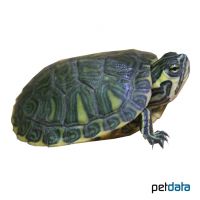Yellowbelly Slider (Trachemys scripta scripta)
| Yellowbelly Slider Trachemys scripta scripta | |
|---|---|
| Name | Yellowbelly Slider |
| Name Lat. | Trachemys scripta scripta |
| Family | Pond Turtles & Box Turtles |
| Family lat. | Emydidae |
| Order | Turtles |
| Order lat. | Testudines |
| Origin | North America |
| Habitat | Rivers |
| Diet | Fish, insects, plants, fruits |
| Humidity | 60-80 % |
| Behavior | Peaceful |
| Keeping | Individual, group |
| Care Level | Moderate |
| Reproduction | Oviparous |
| Housing | Aquaterrarium |
| Life Span | 25-30 years |
| Protection | EU-DVO 2016/1141 Invasive alien species |
| Metric Units | |
| Size | 25-30 cm |
| Temperature | 24-28 °C |
| Temperature Local | 35-40 °C |
| Housing Size | 150 x 60 x 70 cm |
| US Units | |
| Size | 10"-12" |
| Temperature | 75-82 °F |
| Temperature Local | 95-104 °F |
| Housing Size | 60" x 25" x 30" |
Distribution and habitat
The range of the yellow-cheeked slider turtle extends from southern Virginia to northern Florida (USA). They live in shallow, slow-moving waters with soft, muddy bottoms and dense vegetation.
Maintenance
Minimum dimensions for the aquaterrarium, according to the size and number of animals
| floor space for 1-2 animals: 5PL x 2,5PL (L x W) | Water level: 2PB |
The carapace length (PL) and carapace width (PB) is measured on the largest animal. For each additional animal, increase the footprint by 10%, and for the 5th animal and larger, increase the footprint by 20%. An aquaterrarium of e.g. 150 x 60 x 70 cm is recommended, which should be placed in a quiet place.
The water part with a substrate of sand or fine gravel, should be structured with roots, aquatic plants and larger stones (hiding places), some of which reach the water surface. In addition, they need a land part with a soft substrate, with plants and roots, as well as sunny spots. To maintain water quality, a powerful filter with low flow and frequent water changes are recommended.
| Water Temp | lighting | Sunny | |
| Summer | 20-28 °C | 12-14 hrs. | 35-40 °C |
| Winter (2-3 months) | 10-14 °C | 6-8 hrs |
They need high light intensity and daily UV irradiation as well as sunny places with radiant heat.
Diet
Juveniles feed predominantly on animal food, whereas adults feed predominantly on plant food. The food supply consists of live insect larvae, snails, earthworms, meal beetle larvae, shrimp, fish pieces, supplemented with pelleted or freeze-dried ready-made food for aquatic turtles. Frozen food is also well accepted. In addition, they absolutely need vegetable food, such as lettuce, dandelion, endive and aquatic plants (e.g. waterweed) as well as, individually varying, sweet fruit. Regular addition of minerals and vitamins is important
A varied diet promotes health and prevents deficiency symptoms.
Reproduction and breeding
Males have a concave ventral carapace and a much longer tail than females. The anal opening of the male is closer to the tip of the tail than in the female.
A small, sandy patch of land is required for oviposition (5-9 eggs). The incubation period is 60-65 days at a temperature of 28-30 °C.
Life expectancy can be 25-30 years.
Important
They like to bask on flat stones or on floating branches. Winter dormancy can be in water or earth-moist substrate
The terrarium must have good ventilation without drafts and meet the species-specific needs. Measuring devices such as thermometers, hygrometers, etc. are necessary. The lighting has to correspond to the species-specific day-night rhythm and has to be placed in such a way that the animals cannot injure themselves. The terrarium should be locked in such a way that neither unauthorized persons can open it nor the animals can escape. Contamination must be removed regularly.
Further literature can be found in your pet store.
References
Text: Christian Sänger; Image: petdata
Source: BMELV (1997): Tierschutzgutachten - Mindestanforderungen an die Haltung von ReptilienENGELMANN (2006): Zootierhaltung - Tiere in menschlicher Obhut: Reptilien und Amphibien, Harri Deutsch Verlag; ROGNER (2009): Taschenatlas Schildkröten, Verlag Ulmer
- Gemäß § 21 Abs. 5 Tierschutzgesetz idgF
